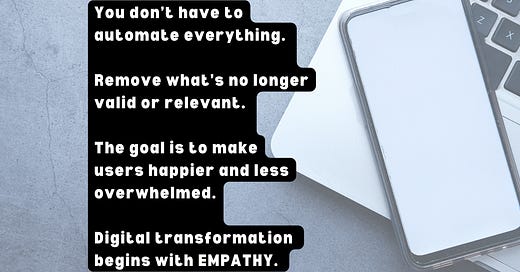From 0 to Digital Transformation Strategist in 3 Conversations
The 21-day roadmap I wish someone gave me too
“Anong unang kailangan ko aralin?”
(What should I study first?)
A few days ago, a close friend messaged me this.
He was stepping into a new role as a digital transformation officer, and didn’t know where to begin.
What followed was a mix of huge chunks of messages, links, real talk, and advice I wish someone had given me when I first stepped into tech consulting.
We had three conversations via Facebook Messenger.
We mapped out his first 21 days to help him build confidence, ask better questions, and lead with curiosity.
Here’s how we approached it:
Week 1: Listen Before You Lead
When you’re new in a role, especially one that sounds big and fancy like “Digital Transformation Officer,” your first instinct is to prove yourself.
Show them you’re smart.
Suggest a new system.
Recommend AI.
But I told him, “Don’t, that’s a big mistake! Not yet.”
Instead, I asked him to imagine walking into someone else's kitchen. You don’t start rearranging their spices or throwing out their old pans.
You look around first.
Observe.
Listen.
So I said, “Spend your first week learning how the kitchen runs.”
He started reading the company’s website, looking for what was missing, testing the contact forms, and noting what was weird, clunky, or ugly.
Based on his end-user experience, he listed questions and observations.
He messaged me, “I think their Order Management process is too manual.”
“Great,” I said. “But don’t solutionize it yet. Keep documenting everything.”
We talked about asking the right question to his new boss:
“What does success in this role look like 90 days from now?”
Then, I told him: “Sit down with people. Don’t interview, more of converse, like having a game of pingpong - easy, light, back-and-forth.”
Grab coffee with IT, Support, Operations, and Marketing heads. Then, ask what’s working and where things are slowing down.
That’s how you begin digital transformation - with empathy.
Week 2: Find What’s Clunky, Not What’s Broken
“You’re not here to fix everything. You’re here to simplify.”
We laughed, remembering how, in his old job, one tool update could throw the team into panic. Everyone hated change, and yet here he was, leading it.
This week was about spotting the friction points and not making folks defensive.
He opened Draw.io, started sketching flows.
one for order entry.
another for ticket handling.
then one for reporting.
“What is this called?” he asked.
“That’s process mapping,” I said. “Draw how it works now, that’s your AS-IS.
Later, you’ll draw how it could work - your TO-BE.
But again: not yet.”
I told him to look for signs:
Are people entering the same data in two systems?
Are they relying on email too much?
Is reporting manual?
He messaged one night: “One of their tools is not even connected to their legacy CRM.”
I replied, “There’s your first opportunity.”
Digital transformation doesn’t always mean buying new platforms. I can mean improving the communication between the current ones.
He started spotting patterns.
People would say, “We always do it this way.”
And he’d write down, “Why?”
When we ask Why at least five times in a row, we’re one step closer to something, and that’s how transformation will begin to make more sense.
Week 3: Paint a Vision, Not a Fix
By the third week, he was ready to show what he had learned.
“Can I suggest something now?” he asked.
“Yes,” I said. “Paint them a picture.”
We worked on a 30-60-90 day plan:
In the first 30 days, clean up outdated templates and map current workflows
By 60 days, propose small experiments, such as automation
By 90 days: recommend a tool or integration, backed by data and user feedback.
He didn’t need fancy tools. He created a “What I Observed” deck using Google Slides, which we reviewed together.
Slide 1: “Here’s what I noticed”
Slide 2: “This slows people down…”
Slide 3: “Here’s one thing we could do”
We also discussed keeping an “Ideas Capture” doc, his private place to collect AHA moments, diagrams, and possible fixes.
I reminded him:
“You don’t have to automate everything.
Remove what’s no longer useful or relevant.
The goal is to make users happier and less overwhelmed.”
The Lesson
Help someone you care about by showing them they already have what it takes.
He managed 70+ agents before.
He knew how to calm sleep-deprived agents.
He knew what “flow” feels like.
We just gave that flow a new container,
process mapping instead of call scripts,
dashboards instead of agent metrics,
systems thinking instead of shifts.
The confidence came later.
The coolest part? He started teaching others what he learned, like how Lucidchart works and why solutionizing too soon ruins trust.
That’s transformation, too.
Final Words
If you’re also moving from operations into something more “digital” or strategic, here’s what I want you to remember:
You don’t need to be a tech expert.
You need to be observant.
Curious.
Willing to ask better questions.
Start with:
– Listening
– Mapping what’s real
– Asking “What if?”
That’s how meaningful transformation begins.
Want Help Simplifying Your Systems?
Figuring out how to lead digital change without being overwhelmed?
That’s where I come in.
I help small teams and business owners untangle messy systems, spot what’s working, and build simple processes that support people rather than stress them out.
If that’s something you’re navigating right now,
Reach out, I’d love to support you.





